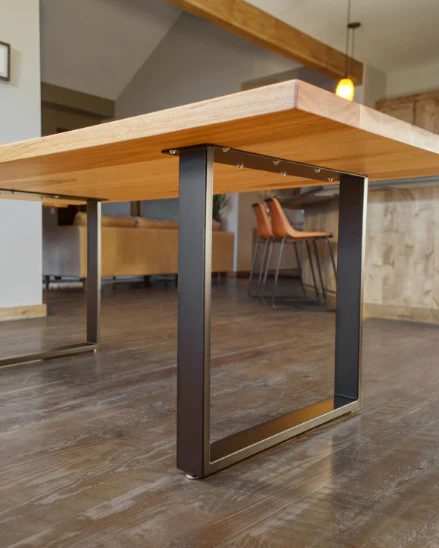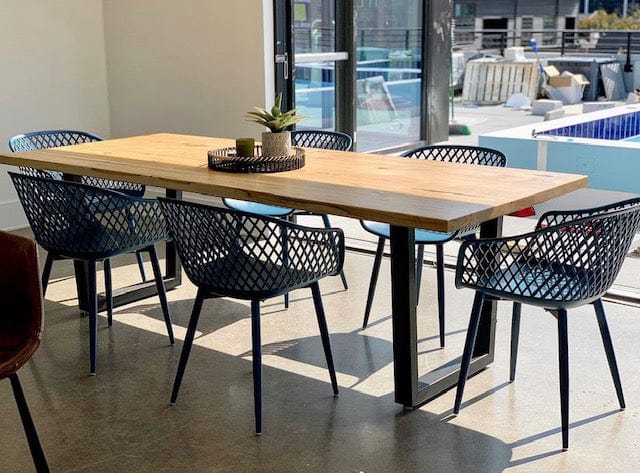Why Custom Dining Room Table Legs Are Worth the Investment
Why Custom Dining Room Table Legs Are Worth the Investment
Blog Article
Specialist Tips for Installing Dining-room Table Legs for Optimum Security
When it concerns setting up dining-room table legs, achieving optimum security is extremely important for both capability and looks. The process begins with picking the right materials and equipment, adhered to by thorough alignment and consideration of weight circulation. Each step plays a critical role in making certain that the finished item endures day-to-day usage without endangering safety and security or layout stability. Recognizing the nuances of these components can substantially affect the total end result. What details strategies can boost stability even additionally?
Choose the Right Legs
When picking the ideal legs for your dining-room table, it is necessary to consider both functionality and aesthetic appeals. The legs you pick will significantly influence the total style and stability of the table. Assess the table's meant use; if you anticipate regular events, stronger legs, such as those made from strong wood or metal, may be much more appropriate, as they use boosted longevity and assistance.
Standard eating tables commonly range from 28 to 30 inches in height, so make certain the legs straighten with this criterion for comfort. Conical legs can include a contemporary touch, while transformed legs may convey an extra traditional aesthetic.

Select Appropriate Hardware
Exactly how can the appropriate hardware improve the security and long life of your dining space table? The option of appropriate hardware is important to guaranteeing that the legs of your table are safely connected and able to endure regular usage. Top notch screws, screws, and brackets offer the essential stamina to support the weight of the table, along with any extra tons put upon it throughout gatherings or meals.
When selecting screws, choose those made from sturdy products such as stainless steel or brass, which resist corrosion and preserve stability gradually. The size of the screws is just as vital; they need to penetrate deeply into the table's structure without compromising integrity. For bolted connections, consider using lock washers to stop loosening up as a result of resonance or activity.
Additionally, using edge braces can add extra assistance, particularly for larger tables or those with heavier tops. These braces distribute weight evenly and aid preserve the table's form. Making certain that the equipment you select is ideal for the certain materials of your table will certainly additionally enhance its total stability and durability, enabling you to appreciate your dining experience for years to come.
Ensure Appropriate Alignment
Appropriate placement of dining space table legs is essential for both aesthetic appeal and functional stability. To accomplish optimal alignment, start by determining the distance from the table's edges to the leg attachment points.
Utilize a level during installation to validate that each leg is vertical to the tabletop. It is advisable to mark the preferred leg placements on the bottom of the table with a pencil or covering up tape before safeguarding them.
In addition, confirm the positioning after the initial screws are tightened, as modifications may be necessary before totally safeguarding the hardware. By prioritizing correct placement, you not only improve the table's general layout but also the original source guarantee that it stays useful and stable for many years ahead.

Take Into Consideration Weight Circulation
After guaranteeing appropriate alignment of the dining-room table legs, it's essential to think about weight circulation to improve security and performance. dining room table legs. Correct weight distribution is vital in protecting against making sure and tottering that the table can sustain its designated lots without threat of tipping or collapsing
When placing the legs, guarantee they are positioned at equivalent distances from the facility of the table to equally disperse the weight throughout the structure. Think about the weight of the table top and any type of products that will often hinge on it, such as attractive pieces or tabletop home appliances. Tables with heavier surfaces must ideally have legs positioned closer to the edges, as this optimizes the base of assistance and lessens the threat of instability.
Furthermore, if the table is meant for usage in a high-traffic location, consider making use of much heavier materials for the legs or adding maintaining components, such as cross-bracing or a reduced rack - dining room table legs. These changes can aid maintain balance and prevent shifting throughout usage. Ultimately, a well-considered weight circulation approach will considerably improve the table's general efficiency, guaranteeing it remains a functional and appealing centerpiece for your dining space
Test Stability Prior To Usage
Examining the security of the dining room table before use is an important step that ought to not be neglected. If the table shows instability, determine the legs or joints that may call for change.
Following, check that all bolts and screws are tightened up appropriately. Loose connections can lead to instability and possible damages in time. If required, make use of timber glue on joints to enhance stability, ensuring to allow ample drying out time.

Conclusion
To conclude, the installation of eating area table legs requires careful factor to consider of materials, equipment, weight, and positioning circulation to achieve optimum security. By selecting durable legs and high-quality bolts, making certain accurate placement, and distributing weight equally, the architectural honesty of the table can be considerably improved. Performing a security test prior to regular use additionally ensures that the table will stand up to day-to-day stress, thereby offering a reliable and safe eating experience.
When it comes to installing dining space table legs, attaining optimum security is critical for both functionality and appearances. The legs you select will significantly affect the overall design and security of the table (dining room table legs). Common eating tables commonly next range from 28 to 30 inches in height, so make sure the legs line up with this advice requirement for comfort.Appropriate positioning of dining room table legs is vital for both aesthetic charm and practical stability.In conclusion, the installation of eating area table legs needs careful consideration of materials, weight, alignment, and equipment circulation to accomplish optimum stability
Report this page